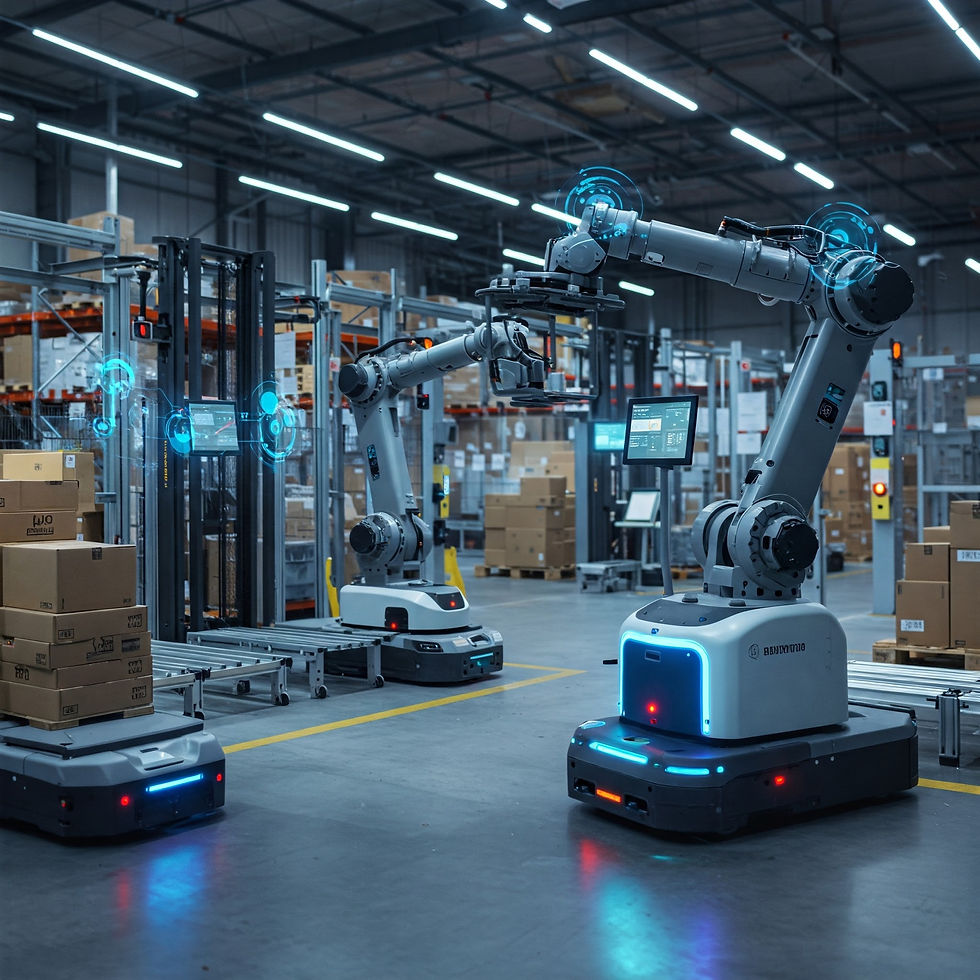The Symphony of Automation: AI in Smart Warehouses
- Phoenix

- Mar 12
- 8 min read
Updated: Dec 2

🎶Orchestrating Efficiency, Resilience, and Human Empowerment: "The Script for Humanity" in Next-Generation Logistics Hubs
In the intricate global supply chains warehouses are rapidly transforming from passive storage facilities into dynamic, intelligent nerve centers. Artificial Intelligence is the conductor of this evolution, orchestrating a "symphony of automation" where robots, sophisticated software, and human ingenuity work in concert to achieve unprecedented levels of efficiency, accuracy, and responsiveness. "The script that will save humanity," when applied to these smart warehouses, is our vital framework of ethical principles, human-centric design, and sustainable practices. It ensures that this powerful automation serves not only to optimize logistics but also to enhance worker well-being, reduce environmental impact, and contribute to a more resilient and equitable global trade ecosystem.
This post explores how AI is orchestrating the smart warehouses of today and tomorrow, the transformative impact of this intelligent automation, and the essential "script" that must guide its harmonious development for the benefit of all.
🤖 The Robotic Workforce: AI Guiding AMRs, AGVs, and Automated Picking
A defining feature of the AI-driven smart warehouse is the sophisticated deployment of autonomous robotic systems.
Intelligent Navigation and Task Allocation: Autonomous Mobile Robots (AMRs) and Automated Guided Vehicles (AGVs) navigate warehouse floors with increasing autonomy, guided by AI that optimizes their paths, assigns tasks (like transporting goods from receiving to storage, or from shelves to packing stations), and manages fleet traffic to avoid collisions and maximize throughput.
AI-Powered Robotic Picking and Packing: Computer vision and advanced AI algorithms enable robotic arms to accurately identify, grasp, pick, and pack a diverse range of items with speed and precision, often working alongside human counterparts for complex or delicate tasks.
Enhanced Speed, Accuracy, and 24/7 Operation: These robotic systems can operate continuously, significantly boosting the speed and accuracy of material handling, order fulfillment, and sorting processes, reducing errors and enabling round-the-clock operations.
🔑 Key Takeaways for this section:
AI directs autonomous robots (AMRs/AGVs) for efficient navigation and task execution in warehouses.
Robotic picking and packing systems, guided by AI and computer vision, enhance speed and precision.
This automation enables 24/7 operations and significantly improves material handling accuracy.
📦 Intelligent Inventory Management: AI Ensuring Perfect Stock Harmony
Knowing what you have, where it is, and what you'll need is crucial. AI brings a new level of intelligence to inventory management.
Real-Time Inventory Monitoring: AI leverages data from IoT sensors, RFID tags, computer vision systems (e.g., drones conducting automated stock counts), and WMS inputs to maintain a highly accurate, real-time picture of inventory levels and locations.
Predictive Analytics for Demand-Driven Replenishment: By integrating with broader demand forecasting systems, AI within the warehouse can predict throughput needs for specific SKUs, triggering automated replenishment orders or internal stock movements to ensure optimal availability and minimize holding costs.
AI-Driven Slotting Optimization: AI algorithms analyze product velocity, order patterns, item dimensions, and warehouse layouts to continuously recommend and optimize the storage locations (slotting) of items, minimizing travel time for picking and maximizing space utilization.
🔑 Key Takeaways for this section:
AI provides real-time, highly accurate inventory visibility through diverse data sources.
Predictive analytics enable demand-driven replenishment and proactive stock management.
AI-driven slotting optimization maximizes warehouse space and retrieval efficiency.
⚙️ Orchestrating the Flow: AI in Warehouse Management Systems (WMS)
Modern Warehouse Management Systems are becoming increasingly intelligent, with AI acting as the central orchestrator of all warehouse activities.
Intelligent Task Assignment and Workflow Optimization: AI enhances WMS by dynamically assigning tasks to human workers and robotic systems based on priority, location, skill set (for humans), and current workload, optimizing overall workflow and resource utilization.
Real-Time Operational Adjustments: AI-powered WMS can make real-time adjustments to operational plans in response to incoming order fluctuations, unexpected delays, equipment status, or changing labor availability, ensuring continuous efficiency.
Seamless Integration from Receiving to Shipping: AI helps create a synchronized flow of operations, from the efficient processing of inbound goods at receiving docks to the optimized consolidation and dispatch of orders at shipping, minimizing bottlenecks and maximizing throughput.
🔑 Key Takeaways for this section:
AI transforms WMS into intelligent orchestration platforms for all warehouse activities.
It enables dynamic task assignment and real-time adjustments to operational plans.
AI helps create a seamless, synchronized flow, optimizing the entire process from receiving to shipping.
✨ AI-Powered Quality Control and Predictive Maintenance
Ensuring product integrity and operational uptime are vital in a smart warehouse, and AI provides advanced tools for both.
🔬 Automated Quality Inspection: Computer vision systems powered by AI can inspect goods for defects, damage, or incorrect labeling at various checkpoints within the warehouse, performing these tasks with greater speed and consistency than manual inspection alone.
🔧 Predictive Maintenance for Warehouse Machinery: AI analyzes sensor data from critical warehouse equipment—such as conveyors, sorters, robotic arms, and automated lifts—to predict potential maintenance needs before failures occur, scheduling proactive servicing to prevent costly unplanned downtime.
🔑 Key Takeaways for this section:
AI with computer vision automates and enhances quality control inspections in warehouses.
Predictive maintenance, driven by AI analysis of equipment sensor data, minimizes downtime.
These capabilities contribute to higher product quality and greater operational reliability.
🛡️ Enhancing Safety and Ergonomics with Intelligent Systems
A core tenet of the "script for humanity" is worker well-being. AI in smart warehouses can contribute significantly to safer and more ergonomic work environments.
🚧 AI Monitoring for Unsafe Conditions: AI-powered video analytics can monitor warehouse environments to detect unsafe practices, potential hazards (e.g., spills, obstructions), or non-compliance with safety protocols, triggering alerts for immediate attention.
🤖 Collision Avoidance and Safe Coexistence: Advanced AI ensures safe navigation and collision avoidance for AMRs and AGVs, especially in environments where they operate alongside human workers.
🦾 Augmenting Human Workers: Emerging AI-powered tools like smart glasses providing augmented reality instructions for picking or assembly, or even AI-guided exosuits to reduce physical strain in manual tasks, can enhance worker capabilities and reduce the risk of injury.
🔑 Key Takeaways for this section:
AI enhances warehouse safety by monitoring for unsafe conditions and enabling collision avoidance for robots.
It can support more ergonomic work through tools that augment human capabilities.
The goal is to create a work environment where human and robotic systems operate safely and efficiently together.
❤️ The Human Note in the Automated Symphony: The "Script's" Focus on People
Even in the most automated warehouse, the human element remains indispensable. Our "script" for smart warehouses must prioritize the well-being and empowerment of the human workforce.
Workforce Transformation and Skill Development: As AI automates routine physical and clerical tasks, the roles of warehouse workers are evolving. Our "script" demands investment in reskilling and upskilling programs, preparing employees for roles in human-AI collaboration, system oversight, robotics maintenance, data analysis, and complex problem-solving.
Ethical Worker Monitoring and Performance Management: While AI can provide insights into operational efficiency, any monitoring of worker performance must be transparent, fair, respectful of privacy, and focused on support and improvement rather than punitive surveillance.
Designing for Safe and Effective Human-Robot Collaboration (HRC): Workspaces, workflows, and training must be designed to ensure that human employees can interact safely, efficiently, and productively with autonomous systems. The human should always feel in control and valued.
Ensuring Good Working Conditions: Automation should not lead to an environment where human workers are merely cogs in a machine. The "script" calls for maintaining reasonable workloads, opportunities for breaks, and a supportive work culture.
This human-centric approach ensures that the "symphony of automation" is harmonious and beneficial for all.
🔑 Key Takeaways for this section:
The "script" for smart warehouses necessitates a strong focus on reskilling and upskilling the human workforce.
Ethical guidelines are crucial for worker monitoring, ensuring fairness, privacy, and well-being.
Safe, effective, and empowering human-robot collaboration must be a central design principle.
🎼 A Harmonious Future: Smart Warehouses Serving Efficiency and Humanity
Artificial Intelligence is orchestrating a new era of warehouse operations—one characterized by remarkable efficiency, speed, accuracy, and intelligence. This "symphony of automation," when conducted with the principles of "the script that will save humanity," can lead to far more than just optimized logistics. It can create safer and more empowering workplaces, contribute to more sustainable supply chains by reducing waste and optimizing resource use, and ensure the resilient flow of goods that underpins our global well-being. By ensuring that our technological advancements are always harmonized with human values, ethical considerations, and a commitment to shared benefit, we can build smart warehouses that are not only intelligent but also profoundly serve the best interests of people and the planet.
💬 What are your thoughts?
What aspect of AI-driven automation in smart warehouses do you find most revolutionary or impactful?
What is the most critical ethical consideration our "script" must address to ensure human well-being in highly automated warehouse environments?
How can businesses best prepare their warehouse workforce for a future of close collaboration with AI and robotic systems?
Share your insights and join this vital conversation!
📖 Glossary of Key Terms
AI in Smart Warehouses: 🎶 The application of Artificial Intelligence technologies to automate, optimize, and intelligently manage various operations within a warehouse or distribution center.
Autonomous Mobile Robots (AMRs): 🤖 Robots that use AI, sensors, and onboard maps to navigate warehouse floors dynamically and perform tasks like transporting goods, without needing predefined paths like AGVs.
Automated Guided Vehicles (AGVs): ↔️ Robots that follow marked lines, wires, or use vision or lasers for navigation along predefined routes to transport materials within a warehouse. Often enhanced with AI for better coordination.
Warehouse Management System (WMS) with AI: ⚙️ Software that controls and optimizes day-to-day warehouse operations, enhanced with AI for intelligent task assignment, workflow optimization, and real-time decision-making.
Predictive Maintenance (Warehouse): 🛠️ Using AI to analyze sensor data from warehouse equipment (conveyors, robots, forklifts) to predict potential failures and schedule proactive maintenance.
Robotic Picking (AI-Powered): 🦾 The use of robotic arms, often guided by AI and computer vision, to identify, grasp, and retrieve items from shelves or bins for order fulfillment.
Slotting Optimization (AI): 📦 The AI-driven process of determining the most efficient storage location for each item in a warehouse based on its velocity, order patterns, and physical characteristics to minimize travel time and maximize space.
Human-Robot Collaboration (HRC) (in Warehouses): 🧑🔧🤝🤖 The design of workspaces and processes where human employees and robotic systems can work safely and efficiently in close proximity, often on complementary tasks.
Ethical AI in Logistics: ❤️🩹 Moral principles and best practices guiding the development and deployment of AI in logistics and warehousing, addressing worker well-being, data privacy, safety, bias, and societal impact.
Digital Twin (Warehouse): 💻 A virtual replica of a physical warehouse, its processes, and assets, updated with real-time data and analyzed by AI for simulation, optimization, and predictive insights.

Posts on the topic 🚚 AI in Transportation & Logistics:
The Moral Code of Autopilot: Who Will AI Sacrifice in the Inevitable Accident?
Automotive Arena: Electric Vehicles (EVs) vs. Hydrogen Fuel Cell Cars (FCVs)
Route Optimization: 100 AI Tips & Tricks for Transportation & Logistics
Transportation & Logistics: 100 AI-Powered Business and Startup Ideas
Transportation & Logistics: AI Innovators "TOP-100"
Transportation & Logistics: Records and Anti-records
Transportation & Logistics: The Best Resources from AI
Statistics in Transportation & Logistics from AI
The Best AI Tools in Transportation & Logistics
The Illuminated Network: AI in Achieving Unprecedented Supply Chain Visibility
The Intelligent Network: AI in Modern Traffic Management for Logistics Optimization
The Autonomous Horizon: AI in Driverless Logistics
The Predictive Pulse: AI in Demand Forecasting for Logistics Mastery
The Proactive Engine: AI in Predictive Maintenance for Logistics Mastery
The AI Compass: Navigating the Future of Logistics with Advanced Route Optimization
The Symphony of Automation: AI in Smart Warehouses
AI in Transport: A Revolution on the Horizon




Comments